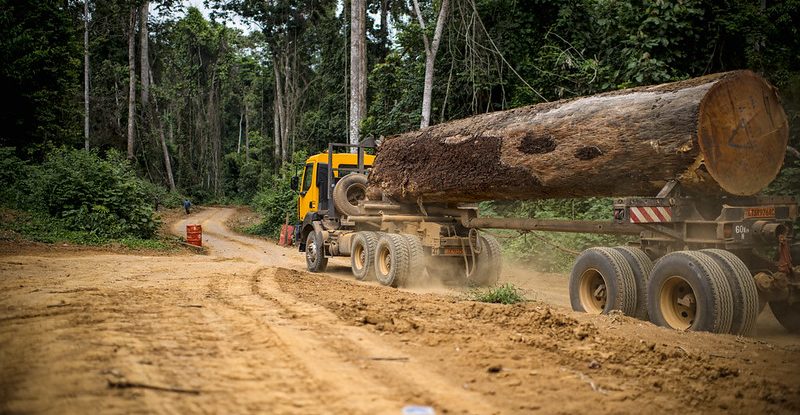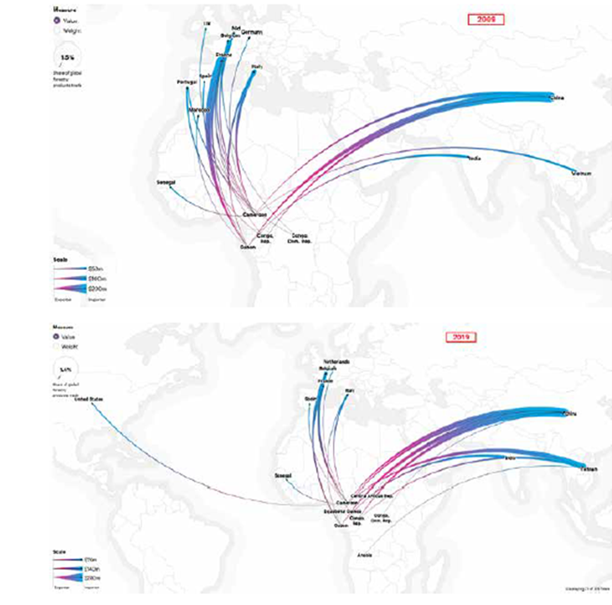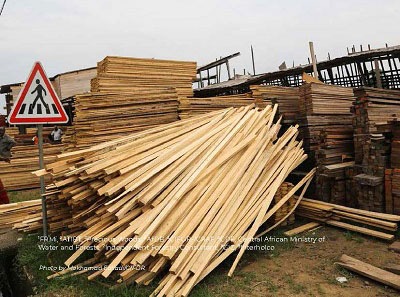
As the global demand for wood soars and considering Central Africa’s large reserves, there is a likelihood that timber export, notably to China and other Asian countries, will ramp up pressure on the sub-region’s 200 million hectares of dense humid forests; over half of which are unclassified, experts have posited in a new report.
In the last 10 years, timber exports to Europe from Central Africa have more than halved, falling from 1.4 billion USD to 600 million USD in value, according the report titled Congo Basin Forests – State of the Forests 2021 and produced by Central Africa Forest Observatory (OFAC). Much of Central Africa’s 4.2 million tonnes of wood over this period has gone to markets in Asia.
According to Nicolas Bayol and other researchers, who examined timber sector trends in the Congo Basin for the report, the implementation of stricter European control measures to guarantee the legality of wood, notably the FLEGT Voluntary Partnership Agreements, has driven wood export from Central Africa to Asia. This trend has positioned China as the sub-region’s first trading partner – with the country buying wood worth 1 billion USD in 2019.
The researchers also advanced the growing lack of competitiveness of products from primary and secondary processing, which Central African countries mostly produce, as reason for Europe’s lack of interest in sourcing from the sub-region. According to the researchers, European importers of raw logs, square-edged timber and scantlings now prefer to turn to competing semi-finished products from South America and South-East Asia since they are cost effective in terms of storage, ready-to-use and can easily be transported by container.
“Despite measures taken to encourage forest operators to develop higher value-added products, the delay by Central African countries remains quite significant due to lack of infrastructures, non-standard transport cost and lack of training in timber-related jobs,” Alain Ngoya Kessy, an independent forestry consultant and one of the contributors to the report, said. This pushes operators to turn to markets in Asia and China which are less demanding in terms of quality.

Trade flows from Central African countries in 2009 and in 2019. Source: ResourceTrade.Earth
It emerged from findings that timber production in Central African countries has relatively been stable in the last 25 years and was spared by the coronavirus pandemic, with production even growing in 2020 to exceed 8 million cubic metres (m³). However, Gabon which unilaterally banned the export of raw logs witnessed a drop in production from 2008 to 2012, when production began to pick up again. In 2019, Gabon returned to its pre-1998 production level and in 2020 topped 3 million m³ – its level of harvesting before the log ban. Across the sub-region, production remains highly concentrated on “flagship” species including Okoume, Sapeli, Frake, Ayous, Limbali, Sorro, Ilomba, Dabema, Tali, Emien, Essia, Padouk S, Eveuss, Ohia/Diana, Fromager and Tchitola.
Besides Gabon which processes the entirety of its harvested timber with the Nkok Special Economic Zone as a reference, the timber processing rate amongst countries of Central Africa varies: Cameroon, 70% of 2.5 million m³; DR Congo, 55% of 300,000 m³; Central African Republic, 55% of 550,000 m³; Congo, 55% of 1.8 million m³; and Equatorial Guinea, 20% of 800,000 m³. But most of the countries’ exports are largely dominated by primary processing.
For several years now, schemes including private certifications and institutional mechanisms have been put in place to incentivize timber producers to adhere to legal and sustainable management approaches. But such efforts in Central African countries have been thwarted by high implementation costs, low-paying markets, pressure from stakeholders, inadequate governance and difficulties in complying with regulatory requirements, until 2018 when the certification dynamic changed. So far, Cameroon, Congo and Central African Republic have signed FLEGT Voluntary Partnership Agreements with the European Union, the researchers said, while DR Congo and Gabon are in negotiation.
While certification schemes help to ensure that only legally harvested timber is traded, poor oversight of the timber sector in local markets – which accounts for a significant portion of timber harvest – undermines the sustainability of forest resources and produces no direct benefits for Central African countries.
Besides contributing to anti-poaching efforts, through agreements logging concessionaires sign with states, the researchers found that logging operations play a key role in maintaining ecosystem services in Central Africa’s 54 million ha of forests of production mainly classified as forest concessions.
“In Central Africa, in selectively logged forests, cutting operations do little harm to the carbon stock, the loss being on average less than 10% of the initial volume of the area cut annually. With a rotation of 25 to 30 years, this represents only about 0.3% to 0.4% of the total annual carbon stock, which is well below the annual growth of tropical forests of about 1.5%,” Caroline Duhesme of International Tropical Timber Technical Association (ATIBT), one of the contributors to the report, highlighted.
To ensure the sustainability of timber resources, the researchers recommended that development plans drawn up in the early 2000s and which have proven to be quite good harvest planning tools must be refined and adapted to the specificities of the concessions. This, as the oldest developed concessions still active in Central Africa are beginning their last five-year cycle.
We want you to share Forests News content, which is licensed under Creative Commons Attribution-NonCommercial-ShareAlike 4.0 International (CC BY-NC-SA 4.0). This means you are free to redistribute our material for non-commercial purposes. All we ask is that you give Forests News appropriate credit and link to the original Forests News content, indicate if changes were made, and distribute your contributions under the same Creative Commons license. You must notify Forests News if you repost, reprint or reuse our materials by contacting forestsnews@cifor-icraf.org.
